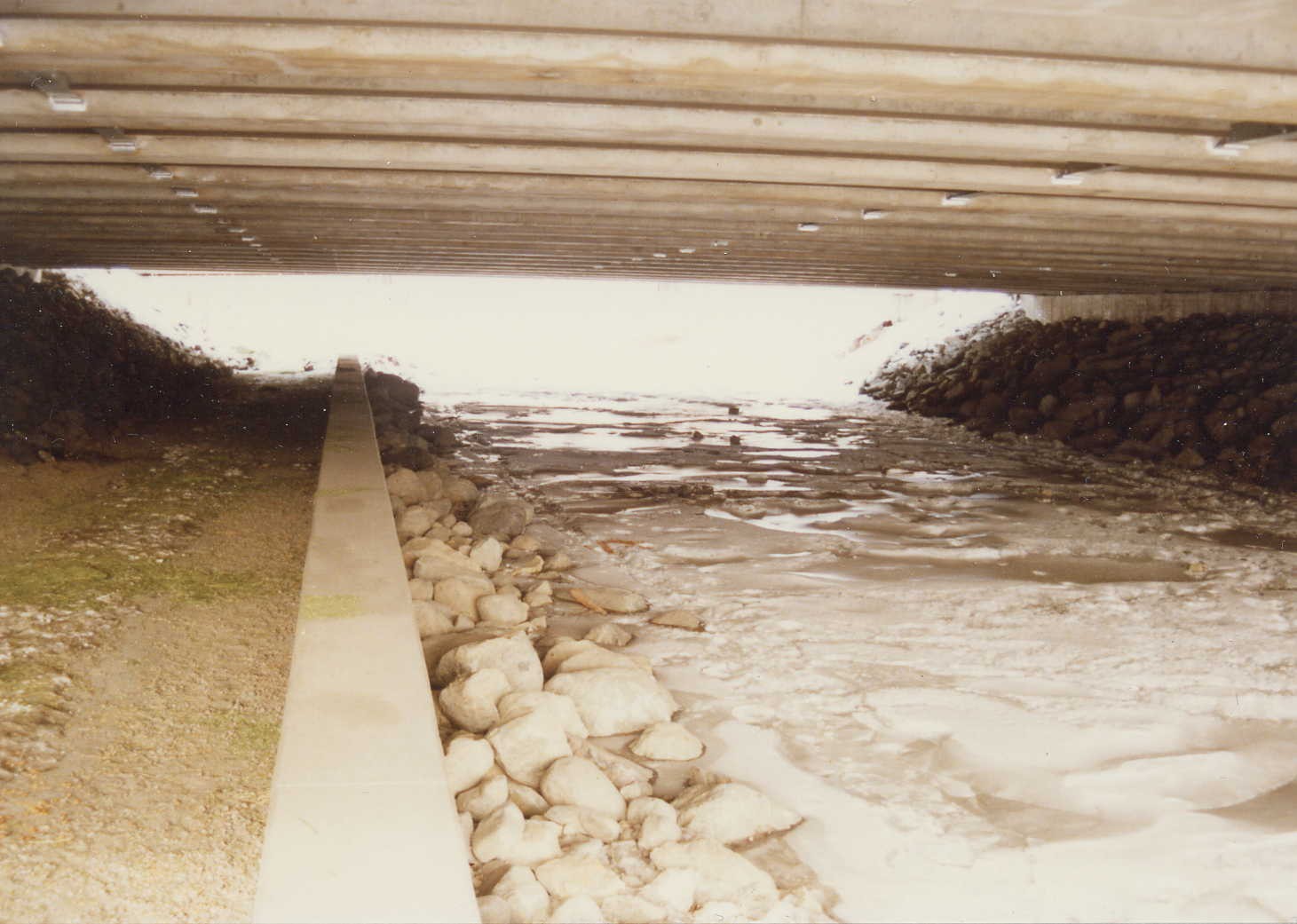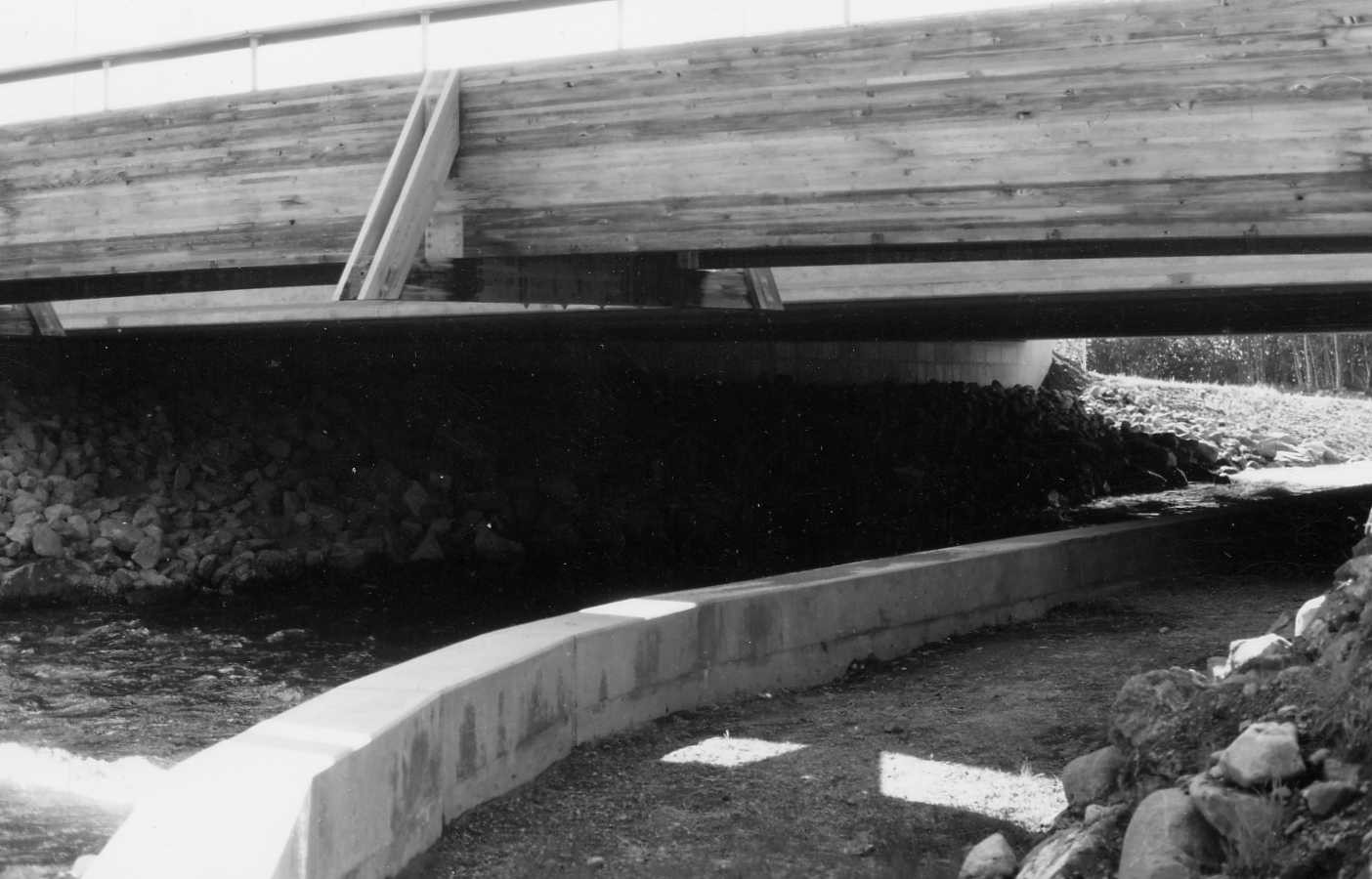Glenn Highway Extended Bridge for Moose
Introduction
The Glenn Highway bisects a major moose winter range just northeast of Anchorage, Alaska. This corridor serves as the only highway connecting Anchorage with Eagle River/Chugiak and the Matanuska-Sustina Borough, and was known for its high incidence of moose/vehicle collisions. Between 1987 and 1990 Alaska Department of Transportation widened an 11.3 km section of the Glenn Highway near Anchorage, Alaska, increasing the highway from four to six lanes. This provided an opportunity to reduce moose-vehicle collisions and increase their permeability across the highway. Ship Creek Bridge was lengthened and raised to accommodate moose, creating an underpass 3 m wide and 3.2 m high. Also installed were moose-proof fencing, one-way gates, and highway lighting on approximately 50% of the roadway that underwent widening. The majority of the project area occurs on U.S. Military Bases, Elmendorf Air Force Base and Fort Richardson Army Base, as well as portions of Chugach State Park and the city of Anchorage.
Novel or Innovative Feature
Ship Creek Bridge was designed to increase the permeability of the highway for moose at this dangerous crossing. In addition, a concrete retaining wall was lengthened and raised to keep flood waters off of the path that led along the creek, increasing moose access to the crossing by eliminating ice build-up in the winter (McDonald 1991). Alfalfa baiting increased moose utilization of the underpass.
Fencing was installed in high-risk sections of the highway, and one-way gates were installed at several locations along the fence to allow moose to escape from the highway corridor. In addition, a single funnel fencing system was built at the intersection with a traffic artery to redirect the moose outside the fence (see diagram). The funnel fence was in a configuration to take advantage of the natural tendency of moose to try to move outward once they see they are confined, while reducing the size of the entry way. Lighting was provided along the entire 11.5 km reconstruction site, illuminating the road surface and roadway shoulders where the animals emerge from dense forests of birch, white spruce, aspen and willow.
Design Issues
No major design or operational problems were reported for the mitigation systems except for one-way gates. There were several problems with the one-way gates including seizing of the gate hinges at low temperatures, reduced movement and incomplete closing of the gates, and failure to restrict moose calves from entering gates the wrong way. Additional lubrication of gate hinges and the addition of rubber boots and metal stops on the hinges reduced the gate movement and closing problems. Bending the tines on the gates closer could also prevent moose calves from entering them the wrong way (McDonald 1991). In addition, lighting systems may have deterred other species from attempting to cross, even at the bridges.
Monitoring and Effectiveness
Pre- and post-monitoring surveys were conducted to establish the need for this project and its degree of success, but post-installation monitoring was not systematic or comprehensive. Throughout the study a total of 66 moose were radio-collared and monitored for location and survival. A pre-construction mortality rate averaging 38 moose per year (1976 to 1987) declined to an average of 12 moose per year (1987 to 1990) after the mitigation devices were in place.
In addition, the lighted area with fences showed a 95% decrease in moose/vehicle collisions, and the lighted area without fences showed a 65% decrease in collisions. It was not determined if the lights deterred the moose from exposing themselves or if the decrease was because motorists could clearly see the animals at a greater distance and take evasive action to avoid hitting them.
One-way gates were frequently used, indicating that many moose were gaining access to the highway via the openings at the ends of the fencing system. Almost thirty percent of the post-construction roadkills occurred near these end points or inside the fence. Only a portion of the 11.3km project was fenced due to funding constraints. Overall, the suite of structures proved to be effective overall in reducing the number of vehicle/moose collisions and there was no substantial post-construction change in the distribution of moose on their winter range.
Additional Information
Garrett, and Conway. 1999. Characteristics of moose-vehicle collisions in Anchorage, Alaska, 1991-1995. Journal of Safety Research, 30(4):219–223.
Jakichuk, R.D. 1986. Design principles for fencing and crossing structures to mitigate mortality of ungulates along highways. Prepared for Coquihalla highway phase III detailed design study team. Anchorage, Alaska. 37pp.
McDonald, M.G. 1991. Moose movement and mortality associated with the Glenn Highway expansion, Anchorage Alaska. Alces Vol. 27(1991) pp.208-219. 12pp.
Reed, D. F., T.M. Pojar and T. N. Woodard. 1974. Use of one-way gates by mule deer. J. Wildl. Manage. 38(1):9-15.
Reed, D. F., T. N. Woodard and T.M. Pojar. 1975. Behavioral response of mule deer to highway underpass. J. Wildl. Manage. 39(2):361-367.
Reed, D. F., and T.D. I. Beck 1979. Regional deer-vehicle accident research. Final report No. FHWA-CO-RD-79-11. State of Colorado, Division of Wildlife. (Prepared in cooperation with the U.S. Department of Transportation, Fed. Highway Admin). 61pp.
Thomas, S.E. 1995. Moose-vehicle accidents on Alaska’s rural highways. State of Alaska Department of Transportation and Public Facilities, Central Region, Design and Construction Division. 66 pp.
Nicole Maggiulli, September 29, 2010
Page Last Modified: February 18, 2014




